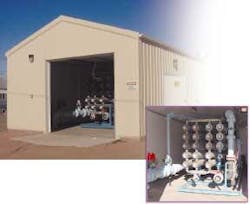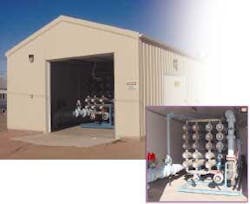Reverse Osmosis Tackles Nitrates in Wyoming Wells
There's nothing more important for a municipality's reputation than being able to deliver clean, safe and good tasting drinking water to every person connected to its distribution system. People know they can turn on the tap with confidence in the unseen process that protects them.
Over a four-year period ending in 1998, that process was being closely studied by the City of Torrington, WY, a primarily agricultural community of nearly 6,000 situated on the North Platte River in the southeastern corner of the state. The city traces its roots back to 1889. The major crops in the area are corn, beans and alfalfa, and local industries include a sugar company and an ethanol plant.
Torrington's citizens consume approximately 2.4 million gallons of water per day supplied by groundwater from multiple wells. The city has six certified operators maintaining the water system, and approximately 2,700 customer taps. The aquifer system is shallow, with some groundwater less than 20 meters below the surface and surrounded by sandy soils that are regularly irrigated. As a result, the city's water source is vulnerable to contamination by anything that migrates through the soil.
The City of Torrington's monitoring program, as well as a U.S. geological survey, revealed that its groundwater had widespread nitrate contamination. The contamination was traced to excessive inorganic nitrates in the soil from the application of commercial fertilizer. Organic nitrates, which usually originate from human sewage or livestock manure, were not a significant factor. Because all nitrates are very mobile in soil, they have a high potential for migrating into groundwater supplies.
The EPA's Maximum Level of Contamination for nitrates is 10 ppm, and some of Torrington's wells were found to exceed that limit. As a result, in 2000 the EPA told Torrington that it had to resolve the nitrate contamination problem promptly or be fined for noncompliance.
Choosing Reverse Osmosis
Equally concerned about the problem, Torrington immediately searched for a new well field with less contaminated source water. At the same time, it also began researching water treatment options for removing the nitrates. After narrowing its choices down to reverse osmosis (RO) and ion exchange technologies, Torrington decided to purchase RO systems. They determined that RO can effectively control a much wider range of contaminants than ion exchange, and would therefore be a wiser capital investment should other contaminants become a problem in the future.
In July 2000, Torrington installed two low-energy Osmo® MUNI-Series™ RO systems from GE Infrastructure Water & Process Technologies that can each process 300 gpm. When tests showed that the new well field was no less contaminated than the current water source, Torrington decided to treat its entire water supply with reverse osmosis. Two more low-energy MUNI-Series systems, each of which can process 450 gpm, were installed in July 2001. The RO systems selected by Torrington are specially engineered for energy conservation in municipal water treatment applications.
Reducing Treatment Costs
The MUNI-Series RO systems use crossflow membrane technology to separate nitrates and most dissolved solids from Torrington's drinking water. The suspended solids are removed in the pre-filtration stage using an Osmonics 5-micron cartridge filter. To maximize RO efficiency, an antiscalant is added to the process to prevent scale buildup in the system. To minimize costs, clean permeate is blended with raw by-pass water at approximately a 1 to 2 ratio depending on the nitrate levels in the different wells.
In the most contaminated wells, the blended water that is used for consumption has more than 70 percent less nitrates than the concentrate. On average, the nitrate level in the RO permeate is 3.6 ppm, and the nitrates level in the blended water is 6.8 ppm, well below the EPA's limit of 10 ppm.
Now that the City of Torrington has improved its drinking water quality and avoided the prospect of EPA penalties, the municipality is looking for ways to make its water treatment systems even more efficient. Instead of treating water from each well individually, the city hopes to be able to feed water from just one well into all four RO systems, a cost saving measure.
The city has already implemented a voluntary education program in the community to minimize the leaching of chemicals into the groundwater, and to promote water conservation measures. A "Water Wise" page with tips for reducing water usage in the home appears on the city's web site. Torrington also posts its annual drinking water quality reports along with helpful information for interpreting the data.
GE Infrastructure Water & Process Technologies, a unit of GE Infrastructure, is a supplier of water, wastewater and process systems solutions. For more information on the company, visit gewater.com.


